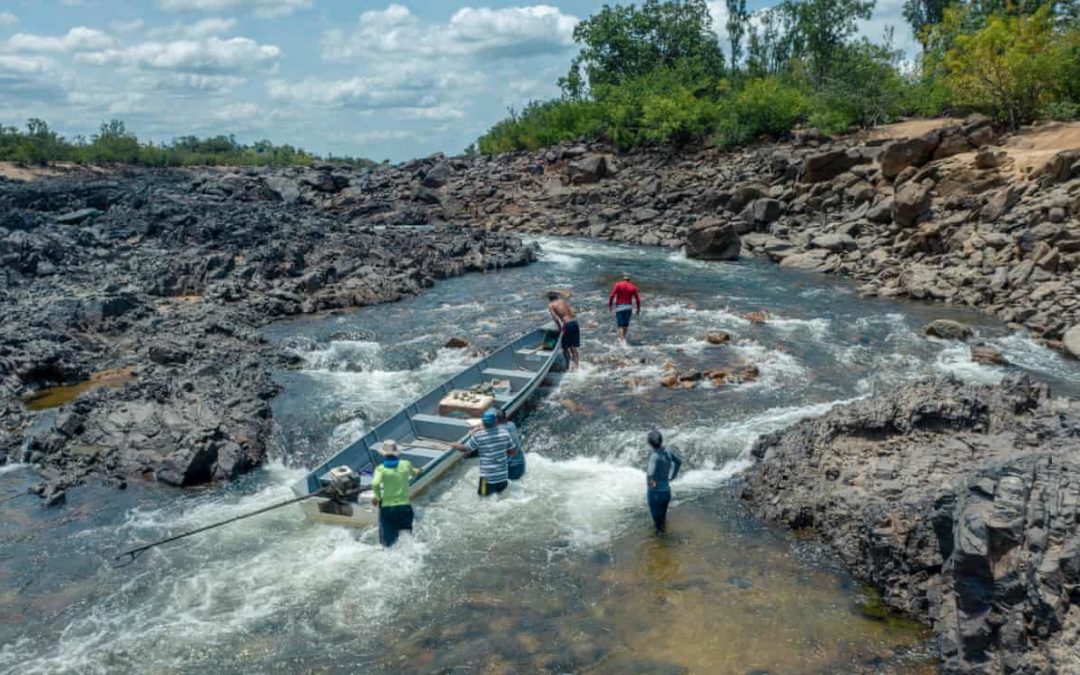SOURCE: The Guardian
DATE: November 8, 2019
SNIP: The biggest hydroelectric project in the Amazon rainforest has a design flaw that poses a “very serious” threat to human life and globally important ecosystems, according to documents and expert testimony received by the Guardian.
After decades of resistance and 40bn reais (£8bn) of investment, the world’s fourth biggest hydropower plant is due to have the last of its 18 turbines installed this month, but lower-than-forecast water levels in the dam’s reservoirs have created an unforeseen structural problem in addition to longstanding environmental, social and economic concerns.
The Guardian and El País have seen a recent report by Norte Energia which warned that the fall in water levels in recent weeks has exposed a vulnerable section of the Pimental dam wall, which is separate from the barrier housing most of the turbines, to waves that sometimes form during tropical storms or strong winds blowing across the reservoir.
The 11 October document – Urgent action to control the level of the Belo Monte HPP Xingu Reservoir – is signed by Norte Energia’s CEO and addressed to the head of the national water agency. It says that water levels fell the previous day to a critical 95.2 metres, which posed a risk that waves “will reach areas of the dam not protected by rock” reinforcements. It asks permission for more water from the intermediate reservoir, a move which would put more pressure on an already strained hydrology.
This is forcing the operators to choose between a structural weakening of the 14km-wide compacted-earth barrier and a reallocation of water in the reservoir or on the Xingu river, which is home to indigenous communities, fishing villages and some of the world’s most endangered species.
The report says the problem arose as a result of unusually low water flows into the reservoir, with several days in early October when it dropped to 750 cubic metres a second. This is substantially below the minimum of 1,000 cubic metres a second that planning documents say is needed to guarantee water quality in the reservoirs and sufficient downstream discharge to ensure a healthy ecosystem, including for a turtle refuge, and indigenous and riverine communities’ navigation.
Hernandez and Sawakuchi said planners had been over-optimistic because historical data showed the Xingu river was lower on at least four occasions during the 50 years before construction started. Climate change is projected to cut water flows by about 30% by 2050. “It’s very strange these problems weren’t foreseen,” Sawakuchi said.
The Belo Monte project has been beset with problems since its inception during the era of Brazil’s military dictatorship. Indigenous and riverine communities allied to oppose the dam system, which blocks one of the Amazon’s biggest tributaries with 2.1m tonnes of concrete and 79.2m cubic metres of earth.
Environmentalists and scientists warned this would devastate one of the world’s most unique biodiversity hotspots. Activists said environmental authorities had issued a license to the dam despite scientific warnings and the concerns of their own technical staff.
Thais Santi, the public prosecutor for Altamira, said. “This is a fault in the construction and the planning.”
She plans to send a formal request to the federal authorities in the coming days for immediate humanitarian assistance to affected residents and a suspension of the dam. She considers this a case of ecocide. “It is already apparent this project is a mistake,” she said. “As well as the death of a river, it will result in the death of people. There is already insufficient food in this area.”
The grim situation is apparent on a motor canoe ride along the volta grande, or great bend, of the Xingu river. Locals explain how the waterway is narrowing and becoming shallower. When we reach the Boca da Terra Preta waterfall, it is no longer navigable. On the exposed rocks are two dead acari fish that appear to have been trapped, desiccated and had their guts ripped out by vultures. On the river bank, sarao trees – which usually provide food for the abundant pacu fish are now so far back that their fruit no longer falls in the water. Fishing communities say their catches are down by between 50 and 80% since the river was dammed.
On a small island in the river, more than 50 locals arrived by boat last week to testify to the problems caused by the dam. As well as increasing hunger and lower incomes, several said they suffered depression as a result of the sudden collapse of the riverscape they had grown up with. “Everything is getting worse,” said Sarah Rodrigues de Lima. “I’ve been fishing here for 35 years but all the fish have fled. The river is drying up.”
Others described how they used to catch filhote, one of the most prized river species, weighing more than 100kg before the dam, but now rarely catch one of even 20kg. Next year is set to be even worse. This will be the start of a new water management system that will prioritise the dam and the ecosystem on alternate years. Even under its best scenario, the volta grande will get less peak rainy season water than during the severe drought of 2016, which killed so many fish that locals refer to it as the “year of the end of the world.”
The new system “will turn the river into a cemetery”, said Cristiane Costa, a biologist working in the office of the public prosecutor. “They are generating energy at the cost of the ecosystem and people.”

